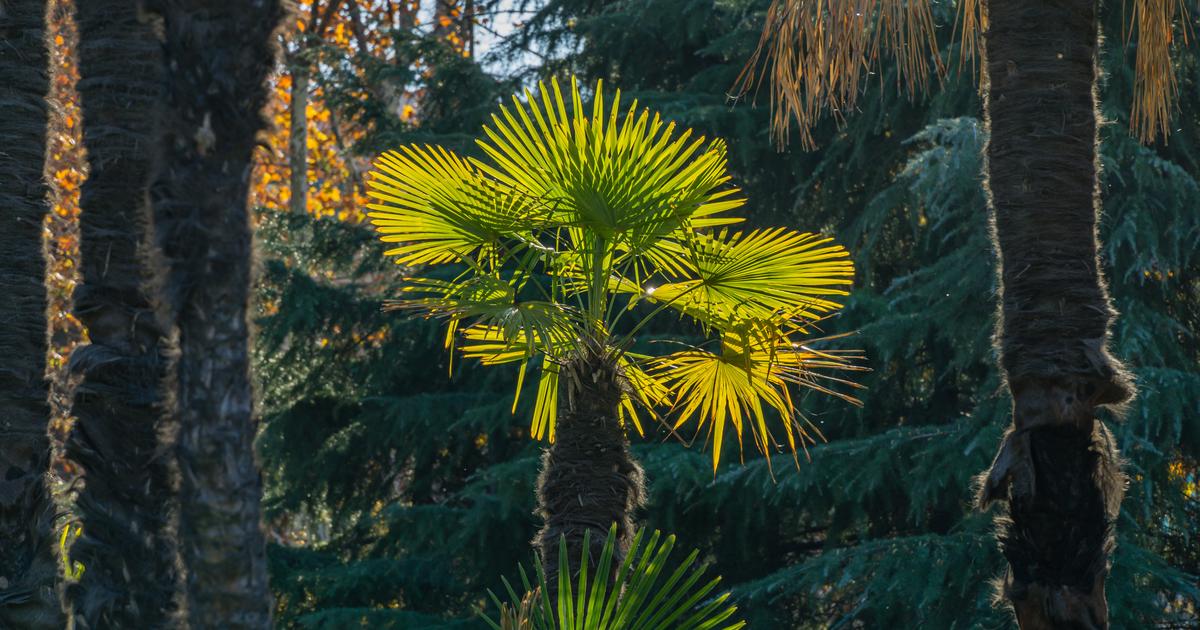The
Chinese palm
whose
Latin name
is
Trachycapus fortunei,
belongs to the Arecaceae family.
It is also called hemp palm.
To discover
DOSSIER - Christmas tree: when to buy it?
Which one to choose ?
All our answers
What are the uses of palmetto?
Ornamental
: with its slender appearance, the Chinese palm tree can sit majestically in the center of a garden, but it can also be grown in rows, in pots or in orangery tubs
Economical
: its stipe (sturdy stem of the palm tree) is used as a building material.
In Japan, its fibers are used to make brushes, clothes, hats, ropes or mats.
In China, palm leaves are used in the composition of carpets.
What are the characteristics of the Chinese palm tree?
Origin
: As its name suggests, the Chinese palm, or hemp palm, is native to an area spread between southern China and northern Burma.
It was imported into Europe from the 1830s, notably by the famous German naturalist Philipp Franz Balthasar von Siebold (1796-1866).
Main characteristics
:
Trachycarpus fortunei
is a slow-growing palm that can measure up to 12 m in height at maturity.
Able to grow up to 2400 m altitude, it is recognizable by its very fibrous brown trunk, which allows it to withstand the rigors of Asian winters.
Endowed with a long very sharp petiole, the leaves, or palms, in the shape of a fan are composed of 30 to 40 segments.
They form a dense crown, dark green, provided with palms of several generations.
The oldest palms turn brown and stick to the stipe, thus protecting the top of the summit crown from the cold.
The latter composed of 3 to 9 fins, is erected towards the sky.
Trachycarpus fortunei
is a dioecious species.
This means that it has male individuals, bearing golden yellow inflorescences in clusters, and female individuals, in which these clusters are creamy yellow.
Much appreciated by birds, the fruits are fleshy ovoid berries of black color with iridescent reflections of blue.
Flowering period:
From June to September.
Hardiness
:
Trachycarpus fortunei
tolerates cold down to -18°C and resists scorching temperatures in summer, up to 35°C.
How to grow Chinese palm?
Level of difficulty:
Easy.
Soil:
Light, rich, fresh and above all well drained because the root system of
Trachycarpus fortunei
does not tolerate excess water well.
This palm also adapts to calcareous, clayey or sandy, acid, neutral or alkaline soils.
Exhibition
:
Full sun, partial shade or shade as long as the roots are dry.
Sowing/planting
:
Sowing can be done from the end of summer indoors or outdoors.
The seeds germinate very easily but are susceptible to rotting.
In the first case, take care to keep the room always well ventilated and if it is a greenhouse, make sure that the heat is not saturated with humidity.
Always let the pots dry out well between each watering.
Outdoors, place a net over the pots to prevent rodents and birds from devouring the seeds.
Plant your Chinese palm tree in spring or at the end of summer, outside periods of cold or very hot weather.
The ideal is to wait for the night temperatures to stabilize above 10°C.
In the ground, the planting pit should be at least twice the size of the root ball.
In alignment, a spacing of at least 2 m will be required between each subject.
Amend the soil so that it is well drained.
A mixture of 2/3 garden soil and 1/3 draining materials (gravel, pozzolan, Loire sand) is perfect, but
Trachycapus fortunei
appreciates a mixture of half garden soil and half potting soil just as much.
In pots, there is no need to choose containers that are too deep because the roots of the palm trees are superficial.
On the other hand, a tank wider than high will be perfectly suitable.
The ideal mix is 1/3 garden soil, 1/3 potting soil and 1/3 draining material (fine clay balls).
Cultivation management
:
Fertilization: It is useless in the ground.
In pots, on the other hand, natural fertilizations can be made, such as nettle manure, twice a year, in early spring and autumn.
Water requirements: quite moderate.
In pots or trays, watering approximately every 3-4 weeks will be more than enough.
Size: the brownish appearance of old palm leaves may make you want to remove them.
However, it is a mechanical protection of the palm tree against the winter cold.
Better to wait for their natural fall.
If, however, the temptation to cut them is too strong, keep the 4 to 5 tallest brown leaves and wait until the end of the spring frosts to operate.
Above all, do not prune the young green palms of the year and do not top your palm: like all monocotyledonous plants, its growth is carried out by the apical bud (the head).
Common diseases and parasites
:
The Chinese palm, rather resistant to common parasites (mites, thrips, scale insects), is very susceptible to the palm moth (
Paysandisia archon
) and the red palm weevil (
Rhynchophorus ferrugineus
).
The first, originating from Argentina and Uruguay, has been raging in the south of France since 1997. The second, originating mainly from Asia, appeared in the Var in 2006 before spreading to the South-East and, the favor of our increasingly mild winters, to extend northwards as far as the Brittany coast.
In either case, the palms dry out or turn yellow and the plant can be doomed within days.
It is important to bag the affected palm and notify the municipal services concerned to stem any spread of these pests on the territory.
Natural solutions can be used, such as the
Steinernema carpocapsae
nematode treatment effective against red weevil.
Sheet produced for the SNHF, by Lise-Margot Dumargne, deputy head of culture at the Versailles-Chèvreloup Arboretum, National Museum of Natural History in Paris.

